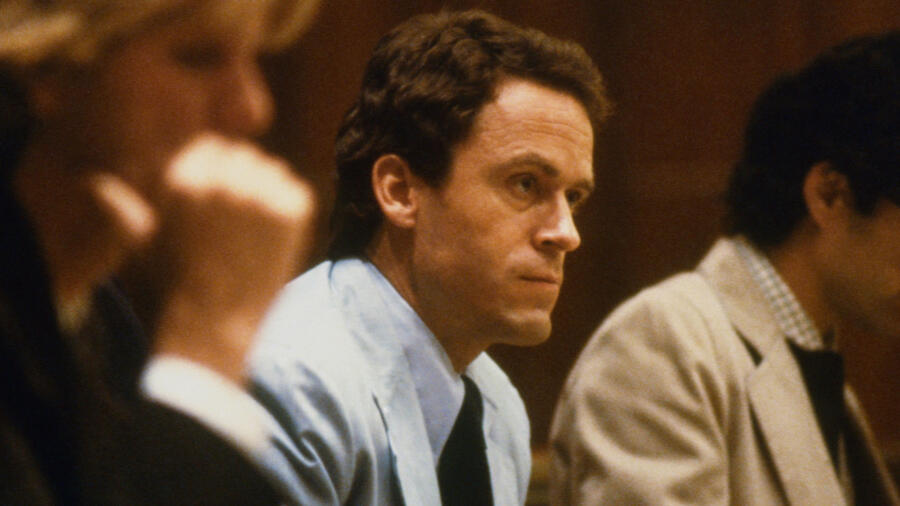By outward appearances, he was the quintessential all-American dreamboat: sharply dressed, with a full head of wavy dark hair; well-spoken, having studied psychology and the law. He defended himself confidently in court. When there was a lull in courtroom activity, he’d sit reading Nobel Prize-winning Russian literature.
Then he’d put the book down and get back to work: insisting he was not one of the most vicious and prolific serial killers in American history—despite overwhelming forensic evidence.
Theodore “Ted” Robert Bundy’s 1979 Miami double-murder trial was televised on dozens of channels across the country, from Florida to Colorado to Washington State. It was a ratings bonanza, with the disconnect between Bundy’s ghastly deeds and his glossy exterior riveting the viewing public.
Ultimately, Bundy was convicted of three of the murders and sentenced to die. On the eve of his execution he confessed to dozens more, admitting that his total might reach into the “triple digits.” Thousands gathered at his execution, which took place on January 24, 1989 via electric chair, cheering the hearse that carried his body away. In the years that followed, his playboy-killer persona would inspire novels and countless movies and documentaries.
[Watch Invisible Monsters: Serial Killers in America in the A&E app.]
A&E Real Crime looks back at the most unforgettable moments from his murder trials.
1. Ted Bundy Escapes from Jail, Pre-Trial. Twice.
While not a part of the murder trial that convicted him, Bundy’s crafty elusiveness of the law in Colorado served as his Florida trial’s preamble, helping turn him into a folk hero before the case had even begun.
First, there was his escape in June 1977 from a courthouse in Aspen. Bundy was facing murder charges and—representing himself—asked the judge that he be allowed to use the local law library for research. He jumped from the second-floor window there and fled on foot.
Aspen came to a halt as the community fixated on his recapture. School was cancelled. Ammunition and guns sales were halted. Business owners began selling Ted Bundy T-shirts.
Bundy was arrested again, and escaped again—this time with a decidedly less comical end result: After moving to Tallahassee, he broke into the Chi Omega sorority house of Florida State University and brutalized four women, killing Lisa Levy, 20, and Margaret Bowman, 21. He raped and killed 12-year-old Kimberly Leach less than a month later before succumbing to his final arrest.
2. ‘I’ll Plead Not Guilty Right Now!’
Bundy’s Florida apprehension set off a media frenzy, which the killer seemed to feed on. As he was read his indictment at the Leon County Sheriff’s Office, he spoke directly to the cameras that had gathered for the occasion.
“Go ahead and read it,” Bundy said, goading the sheriff, before turning to cameras and smiling, saying, “My chance to talk to the press. I’ll plead ‘not guilty’ right now.”
KOA-TV, a Colorado affiliate, descended on Tallahassee that day to talk to those who’d gotten to know Bundy in Florida, including a young co-ed who’d gone on a dinner date with the serial sexual murderer and described him as “friendly.
3. Bundy Puts Himself on the Stand
As his own attorney, Bundy often subjected the court to a surreal spectacle of third-person self-reference, calling himself “Mr. Bundy” throughout his double murder trial in Miami.
When he put himself on the stand, his confidence and nonchalance captivated audiences nationwide. Dressed in a khaki blazer and a Seattle Mariners sweatshirt, Bundy calmly grinned through a lengthy cross-examination.
John Henry Browne—one of several attorneys Bundy briefly worked with—described the killer’s willingness to take the stand as a fatally narcissistic miscalculation in his book, The Devil’s Defender.
“Ted believed he could lie his way out of anything and could charm the judge,” writes Browne. “He was wrong.”
4. Looks That Kill, and a Killer Wedding
Serial killers often draw a disproportionate amount of romantic attention, given how poorly suited they are as potential mates. The phenomenon even has a name: hybristophilia.
But even within the context of that bizarre phenomenon, Ted Bundy was an outlier. Scores of female admirers crowded his trial, done up as they understood Bundy to prefer his victims: in hoop earrings, with long hair parted down the middle.
One of those fans, Carole Boone, struck up a romantic relationship with him, saying he had a “playful, silly” side. Their nickname for one another, Boone said, was “Bubbles.”
The Bundy-as-romantic-antihero storyline reached its apex at Bundy’s second murder trial, in Orlando. There, Bundy called Boone to the stand and proposed marriage.
She said yes, and they were wedded on the spot. (Boone had arranged a notary public to be present in the courtroom.) Against prison rules, they conceived a child, Rose Bundy, during one of her visitations to Death Row.
5. With Some Regret, A Judge Sends Bundy to the Electric Chair
After Bundy was convicted for the sorority killings, Judge Edward Cowart followed the jury’s recommendation and imposed a death sentence. Then, remarking on Bundy’s considerable intelligence, the judge expressed befuddlement at why the killer would’ve chosen the path he had.
“Take care of yourself, young man,” Cowart said. “I say that to you sincerely—take care of yourself. It is a tragedy for this court to see such a total waste, I think, of humanity that I’ve experienced in this court. You’re a bright young man. You would have made a good lawyer and I would have loved to have you practice in front of me— but you went another way, partner.”
Related Features:
Ted Bundy’s Childhood: Lonely Boy to Window Peeper to Serial Killer
What Was Ted Bundy’s Execution Like?
Ted Bundy, the Sexiest Serial Killer?



